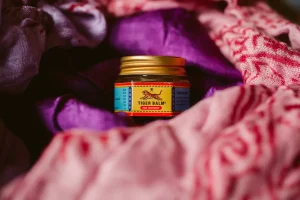Tiger Balm, a well-known topical ointment that is frequently used to relieve joint and muscle pain, has gained trust in homes all over the world. Nevertheless, even though Tiger Balm is widely used, in some places it is prohibited or restricted. This article will discuss Tiger Balm’s ingredients, the reasons it is prohibited in some places, and how these problems have prompted regulatory action.
Tiger Balm: What is it?
Let’s first discuss what Tiger Balm is before delving into the reasons why it is prohibited in some locations.
Essential oils such as camphor, menthol, cajeput oil, and clove oil are combined to make Tiger Balm, a herbal ointment. It is mainly used to treat minor sprains, headaches, and muscle pain. It has long been used as a treatment for minor aches and pains in many cultures, especially in Southeast Asia.
Although the majority of people can safely use the balm, its ingredients—some of which may be regulated—are the source of the controversy.
What Makes Tiger Balm Illegal in Some Countries?
1. Control of Camphor and Menthol
Menthol, which is made from peppermint oil, is one of Tiger Balm’s main ingredients. Although menthol is frequently found in many over-the-counter products, excessive absorption of it can have serious negative effects on certain people.
Another important component, camphor, can be harmful if consumed or used in excess. This has sparked questions regarding Tiger Balm’s safety, particularly for young people, expectant mothers, and people with underlying medical conditions.
The use of products with high levels of menthol or camphor has been restricted in some nations, including the US and Canada. These limitations are in place to avoid unintentional poisoning or negative reactions.
2. Health Hazards and Adverse Reactions
Inappropriate use of Tiger Balm may result in adverse effects like:
-
Burns or skin irritation
-
Reactions to allergens
-
Breathing difficulties (if inhaled in large quantities)
-
Discomfort in the stomach (if ingested)
Young children are especially susceptible to Tiger Balm’s negative effects. Serious poisoning can result from ingesting even a tiny quantity. Because of this worry, regulatory bodies in some areas have prohibited children under a specific age from using Tiger Balm.
3. Barriers to International Trade
International trade regulations are another factor contributing to Tiger Balm’s illegality in some nations. Imports of goods containing specific ingredients may be prohibited or subject to restrictions in some nations, especially if those goods do not meet local safety regulations. For example, imports of topical ointments with high menthol or camphor content are subject to stringent regulations in EU member states.
Tiger Balm’s Ingredients: Why They Are Important
The main components of Tiger Balm, menthol, camphor, cajeput oil, and clove oil, each have advantages and disadvantages. Let’s examine each in more detail:
Menthol
-
Applications: Due to its cooling properties, menthol is frequently found in cough drops, pain relievers, and balms.
-
Issues: Although it relieves discomfort, it can irritate skin, particularly in those with sensitive skin. Excessive menthol consumption can cause nausea, vomiting, and in severe situations, coma.
The Camphor
-
Applications: Camphor is used to treat colds, coughs, and muscle soreness. It warms the skin.
-
Concerns: Camphor can be particularly harmful to children and is toxic if ingested in large amounts. When camphor is consumed, it can cause symptoms like seizures, disorientation, and in extreme situations, death.
Oil of Cajeput
-
Applications: The cajeput tree yields cajeput oil, an essential oil. It works well to relieve pain because of its analgesic and anti-inflammatory qualities.
-
Concerns: Although cajeput oil is usually safe, some people may experience skin irritation from it.
Oil of Cloves
-
Applications: Clove oil’s analgesic (pain-relieving) and antiseptic qualities make it useful.
-
Concerns: If improperly diluted, it may irritate skin.
Alternatives and Legal Restrictions
1. Nations with Restrictions on Tiger Balm
As was previously mentioned, because of the possible health risks connected to its use, Tiger Balm is subject to legal restrictions in some countries. Products with high concentrations of camphor or menthol are subject to regulations in places like the European Union. Products with these ingredients are frequently prohibited from being sold to children younger than a specific age in nations like the US.
2. Tiger Balm Substitutes
There are numerous topical pain relievers available on the market for people looking for alternatives to Tiger Balm, such as:
-
A common natural treatment for sprains, bruises, and muscle soreness is arnica gel.
-
Eucalyptus oil is well-known for its calming effects and capacity to ease tense muscles.
-
Icy Hot: A popular topical ointment with a menthol base that resembles Tiger Balm.
In Conclusion
Why is Tiger Balm prohibited in some places? The safety issues with its strong ingredients—particularly menthol and camphor—are the cause. Although it is still a widely used treatment globally, some areas have banned or restricted it due to the possibility of overdose or negative reactions, especially in children and sensitive people.
There are substitutes that offer comparable relief without the possible hazards if you live in a nation where Tiger Balm is prohibited or restricted. Before using any topical product, always get medical advice, especially if you have underlying health issues.
FAQ about Tiger Balm
1. Why is Tiger Balm banned in some countries?
Tiger Balm is banned in some countries due to the concentration of ingredients like camphor and menthol, which can be toxic or cause skin irritation when used improperly. Some regions also restrict products with unapproved health claims.
2. Is it safe to use Tiger Balm on children?
While Tiger Balm can be safe for adults, it should not be used on children under two years old. The high concentration of camphor can be toxic if ingested or applied to sensitive skin areas.
3. Can I use Tiger Balm if I have sensitive skin?
If you have sensitive skin, it’s advisable to do a patch test before applying Tiger Balm. If you experience irritation or redness, discontinue use and consult a healthcare professional.




